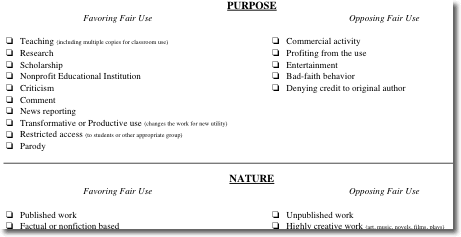Previous: A closer look at the four factors
Checklists for Fair Use
A popular solution to figuring out how the four factors apply to specific uses of copyrighted material is to use a checklist. A variety of checklists have been developed over the years, often by librarians, in order to provide a quick method of assessing whether a particular use of copyrighted material would likely be considered to be a fair use. The advantages of checklists are in their simplification and reduction of the four factors into specific factual elements that either support Fair Use or oppose it.

Fair Use Checklist – Overview and PDF from Columbia University Libraries
When using a checklist, you mark the boxes and then evaluate at the overall result. Are there many more checks in the "favoring" column than in the "opposing" column? If so, the facts of the checklist would seem to indicate the use could be considered a fair use.
it is recommend that you fill out a checklist for each use of copyrighted material that you would plan to claim a Fair Use exemption for. File away the completed checklist with your other records.
Can checklists be trusted?
Not as much as we'd like, but checklists are not completely useless either. A checklist is not a legal document and the Copyright Act does not mention them at all. Indeed recent copyright infringement cases have focused on checklists as the core of the complaint. Theoretically, a checklist could be developed that would affirm any use to be a fair use. In short, a checklist does not guarantee immunity from lawsuits or predetermine a successful fair use defense.
At the same time, reasonable use of Fair Use checklists can serve as a record of a decision-making process in the course of your duties as a university employee. In this regard, checklists provide some protection if the use is determined by a judge to have been unfair. Specifically, §504 (c)(2) of the Copyright Act notes that if you reasonably believed the use to be a fair use at the time (and the checklist could aid in documenting that decision process), any statutory damages arising from the infringement will be "remitted" (i.e., waived).
The bottom line is that checklists are no guarantee that a particular use is fair, but using one is never, by itself, a bad idea.
Checklist summary
- Fill out a checklist to document prior consideration of the four factors
- Offers a means of recording your decision-making process as an employee of the university
- Offers some protection from statutory damages if you believed the use was reasonably a Fair Use
- Fill out a checklist for each use, each time
- File away the completed checklist for future reference
- Checklists are not legal documents or contracts or indemnification from lawsuits.
Next: Conclusion
Updated: November 02, 2022